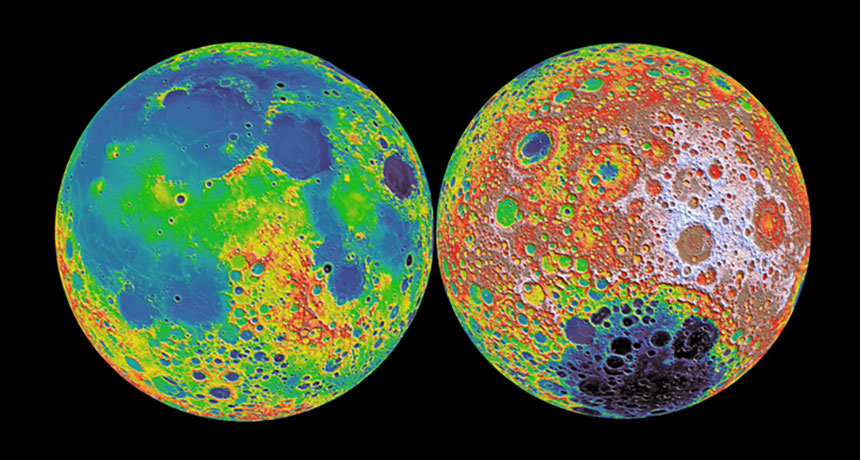Early moon may have had metallic skies and gale-force winds
Early Earth’s glow helped vaporize metals to form a lunar atmosphere with stiff gusts and metallic snow

Details about the moon’s early atmosphere may be stored in its surface. This false-color image shows the lunar surface. Craters and other low-lying areas are blue. Higher regions are red. The near side of the moon appears at left; the far side at right.
NASA, GSFC, MIT, LOLA
The infant moon may have had a thick metallic atmosphere. Intense, super gale-force winds may also have whipped across its surface, raising waves in a fiery ocean of magma.
That’s the conclusion of a new computer model. It ran a series of simulations to test theories of what could have happened early in the moon’s history. It also helped researchers think about the development of some exoplanets — those beyond our solar system — all without leaving Earth’s own neighborhood.
The new simulations pointed to how heat from the young sun, the Earth and the moon’s own hot surface might have vaporized lunar metals to form a thick atmosphere. It could have been as thick as the Martian atmosphere is today.
Researchers reported that assessment online June 22 at arXiv.org.
Most planetary scientists think the moon formed when a Mars-sized protoplanet slammed into Earth. That was some 4.5 billion years ago. The collision flung hot, molten material into Earth’s orbit. That material coalesced, or came together, and eventually cooled into our moon.
At first, the moon would have been covered in a deep, global ocean of magma — hot liquid rock. The post-collision Earth would have been blisteringly hot as well. How hot? Perhaps upwards of 2000° Celsius (3632° Fahrenheit). Earth would have glowed like a small star, specifically a type of star known as a red dwarf.
Prabal Saxena worked on the new study. He is an astrophysicist at NASA’s Goddard Spaceflight Center in Greenbelt, Md. He and colleagues added up the radiation the early moon would have received from its own magma ocean, from the starlike Earth, and from the sun. All of that energy would have vaporized metals in the magma ocean. This would have created an atmosphere about one-tenth the thickness of Earth’s, the model shows.
Previous models had suggested the early moon should have an atmosphere. But the new model is the first to include radiation from the moon, Earth and sun, Saxena’s team says. Pulling all of that information together reveals fresh details. They show how the early moon’s atmosphere and ocean may have interacted.
Saxena and colleagues focused on sodium. It’s an element that vaporizes easily. It also is abundant on the moon. To keep their model simple, they worked with the idea that sodium represented all the components that could contribute to an atmosphere. (In fact, others likely would have played a role too.)
The key to the early moon having an atmosphere was a molten ocean. If it existed, it would have seeded the atmosphere would freshly vaporized atoms from the sodium seas.
Those atoms would have whipped through the metallic air. Why? Because temperature differences on the moon would have had created strong winds. The side facing the sun would have been heated to more than 1700 °C. The side facing away from the sun would have chilled to a frigid ‒150 °C (-238 °F). That temperature difference would have raised winds with speeds over 1 kilometer (0.6 mile) per second. Such winds would probably have whipped up waves in moon’s magma seas.
The moon likely would have experienced snow, too. But not like any snow people have known. When lunar winds hit the zone where hot and cold temperatures meet, the atmosphere would have condensed. A metallic snow would have fallen.
After about 1,000 years, the magma ocean would have cooled enough to solidify into a rocky crust. With no liquid pool to draw from, the entire atmosphere then would have collapsed.
The atmosphere as a ‘rock star’
“The moon’s atmosphere was like a hard-partying rock star,” Saxena quips. “It had a really violent, heavy-metal existence,” he says, after which “it rapidly just fell apart.”
Such a live-fast, die-young picture of the lunar atmosphere sounds like something that could indeed have existed, says Kevin Zahnle. It might even be testable, says this planetary scientist. Zahnle works at NASA’s Ames Research Center in Moffett Field, Calif. The new study’s story is “well within the bounds of the possible,” he says.
Still, he’s not sure if all of its assumptions were good ones. Both Earth and the moon would have had to be “exceedingly dry,” meaning they must not have had much water. If they did, they first should have developed steamy water atmospheres.
One way to test the computer model’s conclusions would be to look for a ring of extra sodium in the rocks around the zone where the sodium snow was supposed to have fallen. That would show that the atmosphere really did have extreme temperature differences and high winds.
Other models of the moon’s formation offer a different scenario. For instance, the moon might have formed from several small impacts instead of a single large one. That would lead to a cooler atmosphere. The winds would not have been as strong, then. There also would have been no sodium snow, Saxena says. So finding that extra sodium could help settle the debate about which kind of impact really happened.
If the scenario with a thick atmosphere, winds and snow holds up, the moon might tell scientists about exoplanets orbiting some far off star. That scenario has Earth glowing like a star. And that would make the early moon a good analog for distant, rocky exoplanets orbiting red dwarf stars, Saxena says. So figuring out what the early moon looked like might offer clues to what is underway on those exoplanets, Saxena says.







